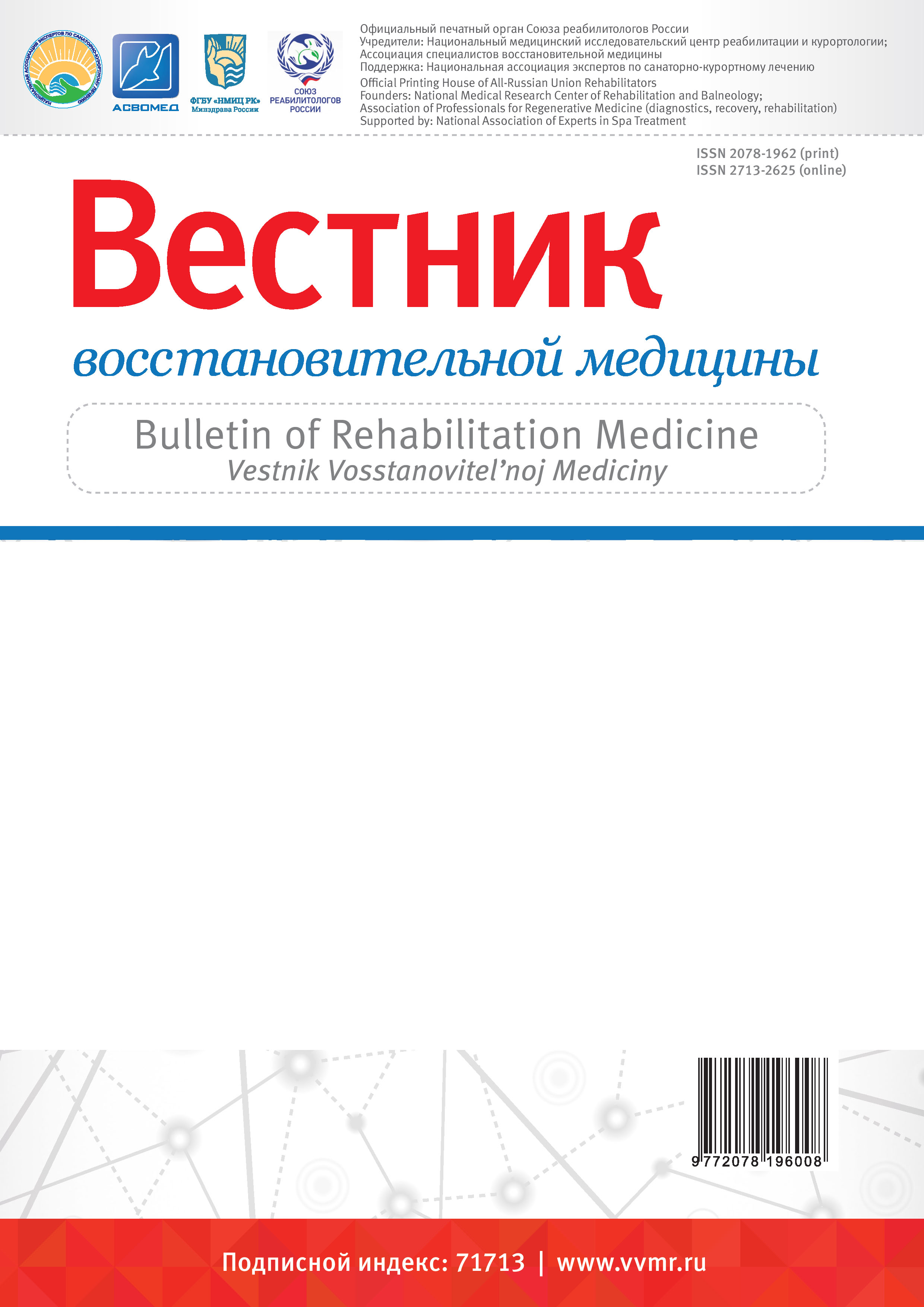Национальный медицинский исследовательский центр реабилитации и курортологии Минздрава России, Москва, Россия
Aim. To study the dynamics of overall tolerance in patients in the early recovery period of ischemic stroke (IS) with mild and moderately severe paresis, to evaluate the effect of aerobic training in this group of patients on exercise tolerance during inpatient treatment as of Compulsory Medical Insurance (CMI). Material and methods. The first group of 30 patients were examined (17 women, 13 men, the average age – 60,6±6,45 years old) during the 4-6 week of IS. Total points of the FIM scale were 118±5,2 /121,8±4,5. The second group- control group consisted of 30 patients with chronic cerebral ischemia (CCI). The following were mainly dominated among the vascular risk factors in both groups of patients: atherosclerosis of brachiocephalic artery of various degrees of severity poorly controlled arterial hypertension, smoking, dyslipidemia. Physical exercise tolerance was assessed by cardiopulmonary testing on a bicycle ergometer using the Quark CPET spiroergometer system from COSMED (Italy). The peak oxygen consumption (VO2 peak), the maximum load performed in metabolic units (MET), the percentage of the proper maximum oxygen consumption (% pred VO2 peak) with constant ECG monitoring, blood pressure during the exercise test were evaluated. Patients with stroke received aerobic training during rehabilitation treatment – 10-12 sessions according to the target indicators. Results and discussion. The minimum required values of VO2 peak to provide an active daily life equals on average 15 -18 ml/min *kg of oxygen. Analysis of the results of our study showed a decrease in the VO2 peak in group 1 of stroke patients to 13.22 ± 3.32 ml/min * kg. The VO2 peak at stroke is only 54.96% ± 12.82 of the proper average values of VO2 and corresponds to 3.73 ± 0.92 MET. The results of the study confirm a very low level of exercise tolerance in the stroke group, which is significantly lower than in the CCI group (VO2 peak is 19.43 ± 4.77 ml/min * kg, which is 83.96 ± 12.93% of the proper average values and corresponds to 5.74 ± 1 .65 MET). The results of the study confirm a very low level of exercise tolerance in the stroke group, which is significantly lower than in the CCI group (VO2 peak is 19.43 ± 4.77 ml/min * kg, which is 83.96 ± 12.93% of the proper average values and corresponds to 5.74 ± 1.65 MET). Cardiopulmonary testing showed the absence of reliable dynamics of VO2 peak (p=0.29) and MET (p= 0.4) at the end of the rehabilitation course. A significant increase in VO2 peak was observed only in some patients who reached a load intensity level of 70% or more of the peak heart rate during training. Later a control study was conducted among 16 patients of the stoke group after 6 months. Cardiopulmonary testing showed the absence of reliable dynamics of the studied parameters in the absence of cardio training ambulatory. Our study of the patients’ with stroke condition in dynamics showed that there was no possibility of spontaneous (without aerobic exercise) restoration of exercise tolerance. Conclusion. In the early recovery period of IS, patients have a persistent long-term decrease of overall tolerance. Aerobic exercises have shown safety and good tolerance in IS rehabilitation programs. Aerobic exercises should be long-term, begin in a hospital and continue during ambulatory treatment. The intensity of training is a key parameter in the adjustment of Aerobic exercises for the patients with IS.
cardiopulmonary testing, ischemic stroke, aerobic exercises, overall tolerance, arterial hypertension
1. Arora R.R., Chou T.M., Jain D., Fleishman B., Crawford L., McKierman T., Nesto R.W. The Multicentrer Study of Enhanced External Counterpulsation (MUSTEECP): effect of EECP on exercise-induced myocardial ischemia and angina episodes. Journal of the American College of Cardiology. 1999; 33(7): 1833-1840. https://doi.org/10.1016/s0735-1097(99)00140-0
2. Abbottsmith C.W., Chung E.S, Varricchione T., de Lame P.A., Silver A.M., Francis G.S., Feldman A.M. Enhanced external counterpulsation improves exercise duration and peak oxygen consumption in older patients with heart failure: a subgroup analysis of the PEECH trial. Congestive Heart Failure. 2006; 12(6): 307-311. https://doi.org/10.1111/j.1527-5299.2006.05904.x
3. Feldman A.M., Silver M.A., Francis G.S., Abbottsmith C.W., Fleishman B.L., Soran O., de Lame P.A., Varricchione T. Enhanced External Counterpulsation Improves Exercise Tolerance in Patients with Chronic Heart Failure. Journal of the American College of Cardiology. 2006; 48(6): 1206-7. https://doi.org/10.1016/j.jacc.2005.10.079
4. Barsness G., Feldman A.M., Holmes D.R, Holubkov R., Kelsey S.F., Kennard E.D., and the IEPR Investigators. The International EECP Patient Registry (IEPR): design, methods, baseline characteristics, and acute results. Clinical Cardiology. 2001; 24(6): 435-42. https://doi.org/10.1002/clc.4960240604
5. Lin S, Xiao-Ming W, Gui-fu W. Expert consensus on the clinical application of enhanced external counterpulsation in elderly people (2019). Aging Medicine. 2020; 3(1): 19-27. https://doi.org/10.1002/agm2.12097
6. Zhou Z.F., Wang D.J., Li X.M, Zhang C.L., Wu C.Y. Effects of enhanced external counterpulsation on exercise capacity and quality of life in patients with chronic heart failure: A meta-analysis. Medicine. 2021; 100(27): e26536 p. https://doi.org/10.1097/MD.0000000000026536
7. Subramanian R., Nayar S., Meyyappan C., Ganesh N., Chandrakasu A., Nayar P.G. Effect of Enhanced External Counter Pulsation Treatment on Aortic Blood Pressure, Arterial Stiffness and Ejection Fraction in Patients with Coronary Artery Disease. Journal of Clinical and Diagnostic Research. 2016; 10(10): OC30-OC34. https://doi.org/10.7860/JCDR/2016/23122.8743
8. Jan R., Khan A., Zahid S., Sami A., Owais S.M., Khan F., Asjad S.J., Jan M.H., Awan Z.A. The Effect of Enhanced External Counterpulsation (EECP) on Quality of life in Patient with Coronary Artery Disease not Amenable to PCI or CABG. Cureus. 2020; 12(5): e7987 p. https://doi.org/10.7759/cureus.7987
9. Caceres J., Atal P., Arora R., Yee D. Enhanced external counterpulsation: A unique treatment for the «No-Option» refractory angina patient. Journal of Clinical Pharmacy and Therapeutics. 2021; 46(2): 295-303. https://doi.org/10.1111/jcpt.13330
10. Wu E., Martensson J., Desta L., Broström A. Predictors of treatment benefits after enhanced external counterpulsation in patients with refractory angina pectoris. Clinical Cardiology. 2021; 44(2): 160-167. https://doi.org/10.1002/clc.23516
11. Medicare now provides limited EECP (enhanced external counterpulsation) coverage. Patient Access. 1999; 22(8): 1-3.
12. Gabrusenko S.A., Malahov V.V., Sergienko I.V., Naumov V.G., Belenkov Yu.N. Pervyy opyt primeneniya v Rossii lechebnogo metoda naruzhnoy kontrpul'sacii u bol'nyh ishemicheskoy bolezn'yu serdca. Terapevticheskiy arhiv. 2006; 78(9): 27-33.
13. Sergienko I.V., Gabrusenko S.A., Malahov V.V., Bugriy M.E., Sergienko V.B. Vliyanie naruzhnoy kontrpul'sacii na perfuziyu miokarda levogo zheludochka u bol'nyh ishemicheskoy bolezn'yu serdca. Kardiovaskulyarnaya terapiya i profilaktika. 2008; 7(7): 85-90.
14. Arora R.R., Chou T.M., Jain D., Fleishman B., Crawford L., McKierman T., Nesto R.W., Ferrans C.E.F., Keller S. Effects of enhanced external counterpulsation on health-related quality of life continue 12 months after treatment: a substudy of the multicenter study of enhanced external counterpulsation. Journal of Investigative Medicine. 2002; 50(1): 25-32. https://doi.org/10.2310/6650.2002.33514
15. Pettersson Th., Bondesson S., Cojocaru D., Ohlsson O., Wackenfors A., Edvinsson L. One year follow-up of patients with refractory angina pectoris treated with enhanced external counterpulsation. BMC Cardiovascular Disorders. 2006; (6): 28 p. https://doi.org/10.1186/1471-2261-6-28
16. Erdling A., Bondesson S., Pettersson Th., Edvinsson L. Enhanced external counter pulsation in treatment of refractory angina pectoris: two year outcome and baseline factors associated with treatment failure. BMC Cardiovascular Disorders. 2008; (8): 39 p. https://doi.org/10.1186/1471-2261-8-39
17. Michaels A.D., Accad M., Ports T.A., Grossman W. Left ventricular systolic unloading and augmentation of in tracoronary pressure and Doppler flow during enhanced external counterpulsation. Circulation. 2002; 106(10): 1237-1242. https://doi.org/10.1161/01.cir.0000028336.95629.b0
18. Vozzi F., Bianchi F., Ahluwalia A., Domenici C. Hydrostatic pressure and shear stress affect endothelin-1 and nitric oxide release by endothelial cells in bioreactors. Biotechnology Journal. 2014; 9(1): 146-54. https://doi.org/10.1002/biot.201300016
19. Yamazaki Y., Kondo Y., Kamiyama Y. Estimation of shear-stress-induced endothelial nitric oxide pro-duction from flow-mediated dilation. Conference of the IEEE Engineering in Medicine and Biology Society (EMBC). 2013; (2013): 4521-4524. https://doi.org/10.1109/EMBC.2013.6610552
20. Luo C., Liu D., Wu G. Effect of enhanced external counterpulsation on coronary slow flow and its relation with endothelial function and inflammation: a mid-term follow-up study. Cardiology. 2012; 122(4): 260-8. https://doi.org/10.1159/000339876
21. Luo J.Y., Wu G.F., Xiong Y., Chen G.W., Xie Q., Yang D., He X.H., Zhang Y., Liu D.H., Wang K.J., Ma H., Zheng Z.S., Du Z.M. Enhanced external counterpulsation promotes growth cytokines-mediated myocardial angiogenesis in a porcine model of hypercholesterolemia. Chinese Medical Journal. 2009; 122(10): 1188-94. https://doi.org/10.3760/cma.j.issn.0366-6999.2009.10.014
22. Karaganov K.S., Lishuta A.S., Belenkov Yu.N. Ispol'zovanie metoda usilennoy naruzhnoy kontrpul'sacii v lechenii pacientov s ishemicheskoy bolezn'yu serdca. Racional'naya farmakoterapiya v kardiologii. 2020; 16(4): 579-584. https://doi.org/10.20996/1819-6446-2020-08-07
23. Kul'chickaya D.B. Shovkun T.V., Yarnyh E.V., Konchugova T.V., Knyazeva T.A., Guschina N.V., Chernyahovskiy O.B., Kolbahova S.N. Vliyanie naruzhnoy kontrpul'sacii na sostoyanie mikrocirkulyacii u pacientov s ishemicheskoy bolezn'yu serdca, oslozhnennoy razvitiem hronicheskoy serdechnoy nedostatochnosti, posle hirurgicheskoy i endovaskulyarnoy revaskulyarizacii miokarda. Voprosy kurortologii, fizioterapii i lechebnoy fizicheskoy kul'tury. 2019; 96(5): 5-10. https://doi.org/10.17116/kurort2019960515
24. Arutyunov G.P., Zvonova E.V. Metod usilennoy naruzhnoy kontrpul'sacii v klinicheskoy praktike. Serdce: zhurnal dlya prakticheskih vrachey. 2009; 8 -(5): 252-257.
25. Birulya A.A., Gromada S.N. Usilennaya naruzhnaya kontrpul'saciya - effektivnaya metodika dlya lecheniya pacientov s ishemicheskoy bolezn'yu serdca na ambulatornom etape. Mezhdunarodnye obzory: klinicheskaya praktika i zdorov'e. 2017; 5-6(28): 136-142.
26. Kuz'mina I.M., Shklyarov A.M., Migunova E.V. Opyt primeneniya usilennoy naruzhnoy kontrpul'sacii s pomosch'yu apparatno-programmnogo kompleksa «Kardiopul'sar» u bol'nyh s rasprostranennym aterosklerozom razlichnoy lokalizacii. Neotlozhnaya medicinskaya pomosch'. Zhurnal im. N.V. Sklifosovskogo. 2017; 6(1): 59-63. https://doi.org/10.23934/2223-9022-2017-6-1-59-63
27. Dolgih O.A., Volkov A.N., Romanchuk S.V., Shutemova E.A. Opyt ispol'zovaniya usilennoy naruzhnoy kontrpul'sacii na dispanserno-poliklinicheskom etape reabilitacii pacientov s refrakternoy stenokardiey. CardioSomatika. 2015; 6(2): 26-29.
28. Badtieva V.A., Voroshilova D.N., Cichinava N.V. Primenenie metoda usilennoy naruzhnoy kontrpul'sacii v lechenii i reabilitacii pacientov s obliteriruyuschim aterosklerozom sosudov nizhnih konechnostey. Voprosy kurortologii, fizioterapii i lechebnoy fizicheskoy kul'tury. 2019; 96(4): 5-11. https://doi.org/10.17116/kurort2019960415
29. Mamieva Z.A., Lishuta A.S., Belenkov Yu.N. Privalova E.V., Yusupova A.O., Rykova S.M. Vozmozhnosti primeneniya usilennoy naruzhnoy kontrpul'sacii v klinicheskoy praktike. Racional'naya farmakoterapiya v kardiologii. 2017; 13(2): 238-247. https://doi.org/10.20996/1819-6446-2017-13-2-238-247






